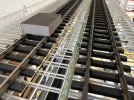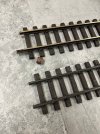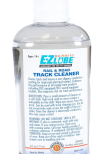You are using an out of date browser. It may not display this or other websites correctly.
You should upgrade or use an alternative browser.
You should upgrade or use an alternative browser.
Cleaning Brass Track
- Thread starter Yardtrain
- Start date
Using any grit of paper will put small groves into the rail attracting more crud from dirty wheels etc. The LGB 50040 is the cleaner of choice as it is a very hard sort of rubber. A few passes of one of these will leave your track surface shiny bright. Massoth do a similar thing and also spare/replacement pads for the block.

 www.pshobbiesandmodelshop.co.uk
www.pshobbiesandmodelshop.co.uk

Massoth 8314301 Track Cleaning Block replacement. Pad
Massoth 8314301 Track Cleaner Replacement rubber.c
Initially, as has been said, use a cloth and little Meths. - Isopropal Alcohol, may be easier for you to source?
Turn the cloth frequently..
If the line has not run for sometime:
Then, I assume, neither will the loco's? - Clean the tyres, skates, and backs of wheels where any carbon 'bullets' rub to pick up power.
You may find the odd rail-joint needs attention, if oxidation has caused continuity problems..
120 grit is way too coarse, really..
You want to polish, rather than abrade the rail head.
Run something like a Stainz, at a reasonable speed. - This will show where you have any problems..
Once you have run a few laps in either direction, go over the track again with the cloth. - You will be amazed, how dirty your 'clean' track is..
The setup looks interesting, any chance of some more pictures?
PhilP.
Turn the cloth frequently..
If the line has not run for sometime:
Then, I assume, neither will the loco's? - Clean the tyres, skates, and backs of wheels where any carbon 'bullets' rub to pick up power.
You may find the odd rail-joint needs attention, if oxidation has caused continuity problems..
120 grit is way too coarse, really..
You want to polish, rather than abrade the rail head.
Run something like a Stainz, at a reasonable speed. - This will show where you have any problems..
Once you have run a few laps in either direction, go over the track again with the cloth. - You will be amazed, how dirty your 'clean' track is..
The setup looks interesting, any chance of some more pictures?
PhilP.
Same here, unfortunatelySadly all the local train shops are gone.
A after moving house I had no garden and a few years later decided to build an indoor layout using the track that had been outdoors for 10 years. I cleaned the top of the rail using the LGB block as suggested.
As I use track power I need to get the ends of the rails where the rail joiners go clean (I used rail clamps). To get the ends clean I smeared some brown sauce (the sort you put on fried eggs) HP was the variety I used. Left it overnight and in the morning all the dirt came off easily with a scrubbing brush and water.
As I use track power I need to get the ends of the rails where the rail joiners go clean (I used rail clamps). To get the ends clean I smeared some brown sauce (the sort you put on fried eggs) HP was the variety I used. Left it overnight and in the morning all the dirt came off easily with a scrubbing brush and water.
tac foley
Registered
A after moving house I had no garden and a few years later decided to build an indoor layout using the track that had been outdoors for 10 years. I cleaned the top of the rail using the LGB block as suggested.
As I use track power I need to get the ends of the rails where the rail joiners go clean (I used rail clamps). To get the ends clean I smeared some brown sauce (the sort you put on fried eggs) HP was the variety I used. Left it overnight and in the morning all the dirt came off easily with a scrubbing brush and water.
It also tastes good!
But NOT after being on the ends of the rails!It also tastes good!
PhilP.
borsig1963
Registered
I used a more drastic method, my LGB tracks have been outside for a few years and moving to an internal track I wanted to do a more aggressive job: round sandpaper (I don't know the grit thickness) on a dremel tool. In the attached photo two tracks, before and after the treatment ...
Attachments
David1226
Registered
On a slightly different tack, I have never understood the concept of testing cosmetics on animals, who wants to buy a lipstick with dog hairs stuck all over it.PhilP test these things, so we don't have to
David
JimmyB
Now retired - trains and fishing
How do you know they were dog hair, they could have come from a pussy cat.On a slightly different tack, I have never understood the concept of testing cosmetics on animals, who wants to buy a lipstick with dog hairs stuck all over it.
David
David1226
Registered
FolliclesHow do you know they were dog hair, they could have come from a pussy cat.
David
Yuk horrible stuff, I am a Worcester Sauce and Hendersons relish man.It also tastes good!
I cant imagine it could make it taste worse!But NOT after being on the ends of the rails!
PhilP.
Doing that on the ends below wheel level ok as you will need clean for track power progression. However as said the surface will clean to shiny with an LGB cleaning block. Yes a bit of faff with a few passes required, but no matter how tarnished the block will do the job. You can even get away with not cleaning the ends if you use Massoth track clamps as the screws will lightly bite into the brass making a good power contact. LGB 51010 graphite paste can be used to help keep power continuity on joints, other brands are available.I used a more drastic method, my LGB tracks have been outside for a few years and moving to an internal track I wanted to do a more aggressive job: round sandpaper (I don't know the grit thickness) on a dremel tool. In the attached photo two tracks, before and after the treatment ...
Rhinochugger
Retired Oik
Yep, white vinegar, or coca-cola - all mild acids. all do the job nicelyA after moving house I had no garden and a few years later decided to build an indoor layout using the track that had been outdoors for 10 years. I cleaned the top of the rail using the LGB block as suggested.
As I use track power I need to get the ends of the rails where the rail joiners go clean (I used rail clamps). To get the ends clean I smeared some brown sauce (the sort you put on fried eggs) HP was the variety I used. Left it overnight and in the morning all the dirt came off easily with a scrubbing brush and water.



